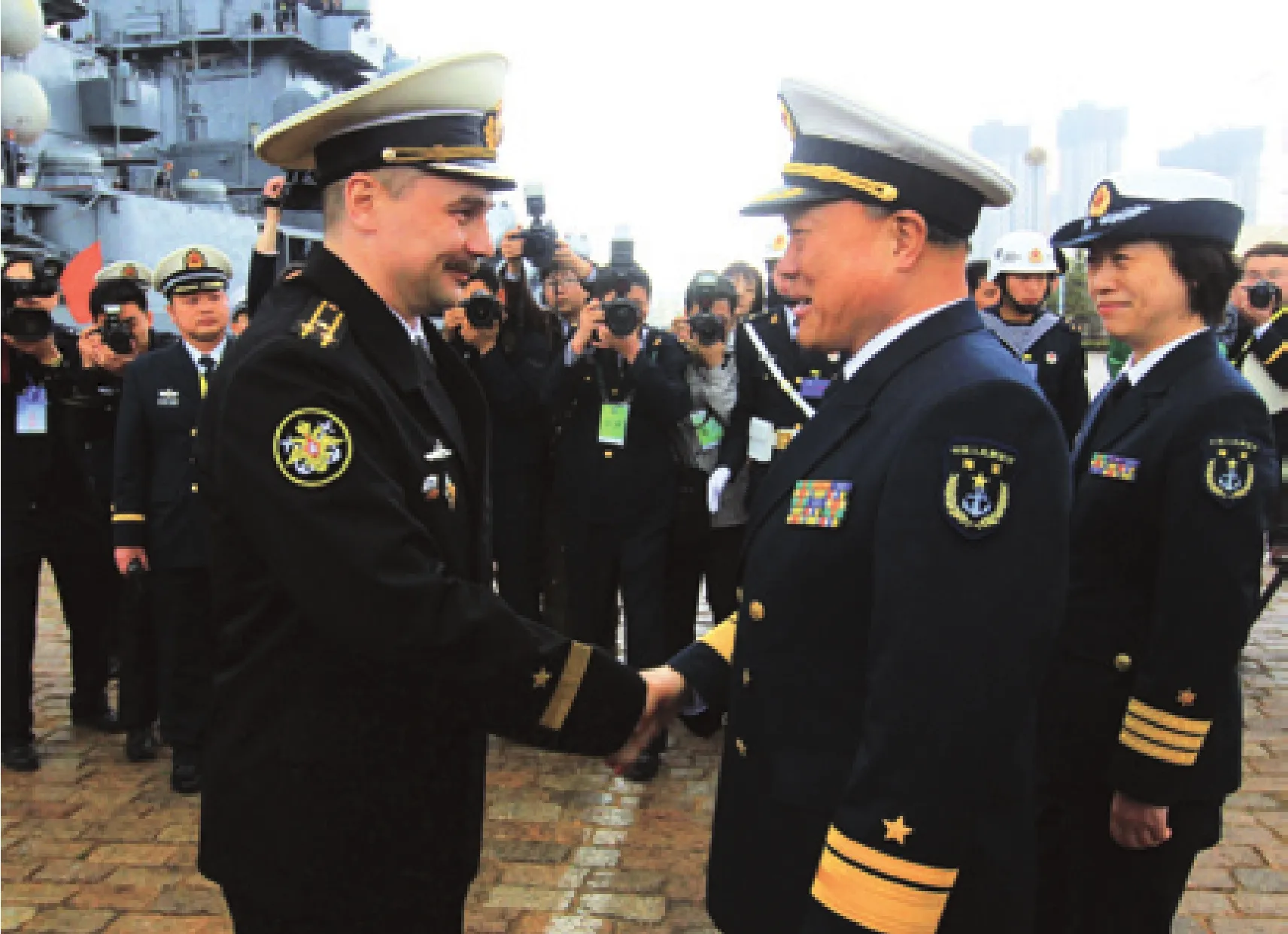Collaboration on the Seas
2012-10-16ThefirstjointnavaldrillmarksnewlevelofmilitarycooperationbetweenChinaandRussiaByLiuFengan
The first joint naval drill marks a new level of military cooperation between China and Russia By Liu Feng’an
Collaboration on the Seas
The first joint naval drill marks a new level of military cooperation between China and Russia By Liu Feng’an

ARRIVAL: The warship Admiral Vinogradov, an Udaloy-class destroyer of Russia’s Paci fi c Fleet,arrives at the Qingdao port, east China’s Shandong Province, on April 21, to participate in the joint naval drill in the Yellow Sea

The author works for the People’s Liberation Army General Staff Department
Between April 22 and 27, China and Russia conducted joint naval exercises in the waters of the Yellow Sea off China’s east coast for the first time, signifying the growing cooperation under the China-Russia strategic partnership.
The six-day joint drill involved 16 surface vessels and two submarines from the Chinese People’s Liberation Army (PLA) Navy and four warships as well as three supply ships from the Russian Pacific Fleet. The Russian Paci fi c Fleet’s fl agshipVaryag, a Slava-class heavy missile cruiser participated in the exercise, along withShenyang, the most advanced missile destroyer in the PLA Navy. The main forces from both navies participating in the drill re fl ected its great importance.
General Qian Lihua, Director of the Foreign Affairs Office with the National Defense Ministry, said the exercise focused on the defense of air routes and maritime traffic routes, search and rescue operations and anti-submarine tactics,as well as joint rescues of hijacked vessels.
“Joint military exercises have grown to be a regular form of cooperation between China and Russia in recent years. The 2012 joint naval drill is a routine arrangement within the framework of bilateral military cooperation,” Qian said. “And the drill is not targeted at any third party.”
Ground breaking
Though China and Russia have conducted four bilateral and multilateral military exercises since 2005, all of them were carried out within the framework of the Shanghai Cooperation Organization, a grouping for regional peace that includes China, Russia and four Central Asian states. The latest naval drill was a breakthrough for China and Russia to hold a large combat exercise in the bilateral framework, ful fi lling the commitment to strengthening their strategic partnership.
The joint naval exercise also has some obvious distinctions by contrast with past events. First of all, it is the largest joint exercise conducted by the two nations, with a total of 25 vessels, 22 aircraft and nearly 10,000 soldiers. The unprecedented marine array was co-led by Ding Yiping, Deputy Commander of the PLA Navy, and Rear Admiral Leonid Sukhanov, Russian naval deputy chief of staff.
PLA Chief of General Staff, General Chen Bingde, said the joint naval exercise aims to counter new challenges and threats together with Russia and secure the peace and stability in the Asia-Pacific region, showing the resolution of China and Russia to rebalance the power structure in the region. This is the fi rst time that the Chinese military has expressed such a purpose for a joint drill. The Chinese Navy previously held joint drills with other countries only for the subject of unconventional security or fi ghting terrorism.
“After consultations with our partner,Russia, the joint drill sets four objectives as follows,” said Ding. “We expect to solidify the strategic partnership between the two par-ties, deepen the practical cooperation between the two militaries, improve the capability of carrying out joint military actions, and strengthen the confidence of securing the peace and stability in related regions through the joint naval drill.”
Chen Guangwen, an independent military expert, said, “The participation of Russia’s fl ag warshipVaryagand other heavy destroyers means the joint anti-submarine mission is the most important task for the naval exercise.”
“The joint drill opens a new approach for the Chinese Navy by including anti-terrorism and conventional combat missions in the exercise,” Chen said.
The Yellow Sea is the most sensitive region in the west Pacific Ocean because the military confrontation on the Korean Peninsula has not ended. Guided by U.S.President Barack Obama’s new strategy, the United States is pivoting to the Asia-Pacific region. At present, nearly 60 percent of the U.S. navy is in the west Paci fi c Ocean, forming a deterrent situation in the region. China and Russia need to play active roles in maintaining the peace of the region.
Cooperation upgrades
The upgrading of ties between the Chinese and Russian militaries showcase the high level of mutual trust. China’s Defense Ministry said the two navies had decided to hold the normal exercises under an agreement reached during a visit by General Chen Bingde during a visit to Moscow last August.
“The joint naval drill pushes military cooperation between China and Russia to a new level,which is a result of long-term efforts made by the two countries,” said Han Xudong, a professor at the PLA National Defense University.
The naval drill used state-of-the-art weapons and vessels, and the objectives set in the drill also expanded. “Thus, it shows that the two militaries have enhanced their collaboration and coordination for large-scale military actions,” Han said.
Years ago, the PLA and Russian military held joint drills of lower intensity. As the cooperation goes deeper, the two sides can implement more complex actions. This time, simulating actual confrontation was the core task for both navies, such as joint maritime air defense, cruising through a dangerous district and joint search and rescue. The intensity and difficulty of the joint drill has escalated on both sides.
“The 2012 joint naval drill has strategic signi fi cance rather than tactical,” Han said. “The argument can be supported by two facts.” One is that both navies sent their strategic forces to the drill, the other is the exercise objectives included main strategic tasks in a battle fi eld.
“From multilateral drills to bilateral drills,from simple to complex, China and Russia are improving their military cooperation through a step-by-step way,” Han said.
It is necessary to clarify that every military needs to test and enhance its armed forces through exercises. Neither China nor its neighbors are exceptions. Thus, there is no need to speculate and worry about each other’s normal military activities, Han stressed.

HAND IN HAND:Du Xiping (second left),Deputy Commander of the PLA’s North Sea Fleet, shakes hands with a senior Russian of fi cer at a welcome ceremony for the arrival of the Russian feet in Qingdao,east China’s Shandong Province, on April 21
